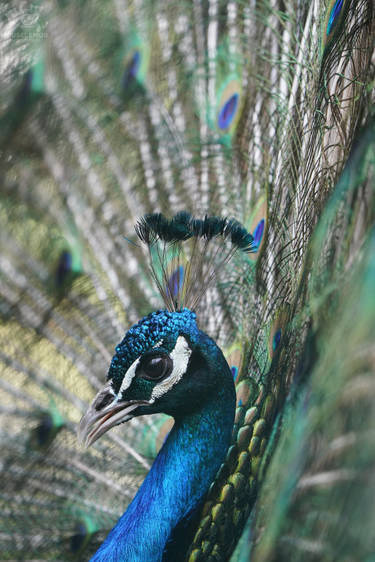 Hello and welcome! Since it is Bird Photography month at @AnimalsPlantsNature, we are presenting to you a new tutorial by Lunnika-Horo:
Hello and welcome! Since it is Bird Photography month at @AnimalsPlantsNature, we are presenting to you a new tutorial by Lunnika-Horo:
How to identify bird
Hi! I'm a young photographer-naturalist but I don't only take pictures of animals and birds - I know exactly what species I have photographed! Today I will share with you a self algorithm - the best ways to understand what bird species you meet

So let's get started!
- Section 1: What you should do if you have heard a new bird sound
- Section 2: What you should do if you have saw a new bird
- Section 3: What you should do if you already have a photo of a new bird
1. You have heard a new sound.
1.1 Listen: Where is the sound coming from?
To start, it is enough to learn the direction: from above/sideways/in front/behind... Figure out where the sound is coming from.
1.2. Find the exact place.
So you decided on the direction. Now your task is to find the exact place. Just go in the direction of the sound and look for a bird. Go toward the loudest sound. If your bird sits in an open place - you were lucky and you will quickly find the right place. If she sings in the woods - begin to bypass the next trees around, looking at top - so to you it will be easier to orient from what tree there is a sound.
- While you look for - it is desirable to write down a melody which the bird sings - on video or a dictaphone. This song will help to identify it further.
- Attention! you cannot rely only on singing - very many birds like to imitate singing of each other and even foreign sounds (such as a door scratch, knock of wheels of the train and many other things)!
1.3. You found the exact place where bird is singing.
As soon as you found the exact place - begin to peer at branches, without forgetting to be displaced concerning a tree around - you could become in the place where branches will precisely hide required. The bird will sometimes change situation, to fly from a branch on a branch - it will help you to notice it.
- If the bird flew on other tree - don't be upset! The main thing - continue to monitor its flight until she sits down. Then you will approach the necessary tree at once and will most likely find it. If you interrupt supervision and run towards the tree where it flew - most likely you will lose it.
2. You find a new bird!
2.1 First - make photograph.  NOT IMPORTANT WHAT!
NOT IMPORTANT WHAT!
Your first picture of a new bird may seem like
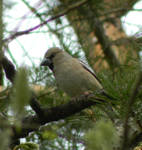
(it is - female of
Coccothraustes coccothraustes) or even like
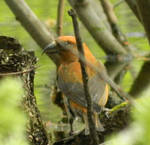
(it is - male of
Loxia curvirostra)
But it is already possible to determine birds, looking on these pictures. Believe me, it is sometimes much better to get the shot--even if it is not perfect--than than to miss the opportunity because the bird flew away. After all, we want to recognize what bird we met! Also, it is even better if you can catch it on several photo with different poses.
If you don't have your camera - try to remember its appearance and habits more precisely. Remember the shape of a beak and talons. It helps to you to identify at least approximately to what tribe your bird belonged, however, without photo you will not be able to check yourself - whether you correctly remembered it.
- If you did not record her singing yet - hurry up!
2.2. Relax and take photos.
After you catch a new bird in different poses, you can relax and now try to find better place to photograph it! To make a masterpiece, try to catch bird in photo not small, but not too large - make it in golden medium

Also, it can be better to catch it on the background, that differs from plumage of a bird, thereby emphasizing her:

(it is - male of
Pinicola enucleator)
Maybe you even can photograph bird while it is doing something interesting

About which parameters you should expose on your camera, read in another
APN tutorial by Mouselemur:
The APN Guide: Setting Up for Bird Photography3. Definition of a picture. Looking for characteristic features.
Small retreat - what is the species and classification: Systematization is a section of biological sciences of which the purpose is the detection of a variety of organisms, development of their classification and clarification of the relations between species and their tribes.
In fact the bird as an organism is a "specie" we are looking for. The international name, by which you will be able to recognize everything about what the mankind knows about the same birds as it.
3.1. Studying details.
Here are some details are necessary to pay attention to when comparing:
Beaks are very different. It is the tool, a hand! (an exception - parrots

) By which the bird is cleaned, builds, and the most important - gets food! For the majority of birds, the beak is ground only under concrete type of food.

Membranes are available for water-loving birds, legs can be strong and then used for running (ostriches, an emu...). Not one, but two fingers behind say that the owner of the foot likes to climb (except owls - they has 2-2 fingers for best holding a prey, also 2-2 fingers has a cuckoo). Big claws are necessary for holding a prey. The feet can be similar to fluffy paw - the accrete fingers covered with plumage (Syrrhaptes paradoxus).
Birds who often adjoin to something slippery can have rough feet: go on ice (penguins) or hold slimy fish (for ex.Pandion haliaetus).
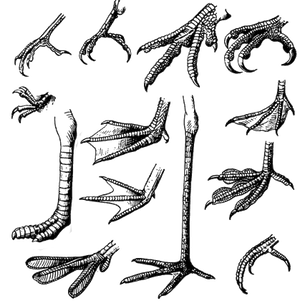
Any speck is important! The spot under a wing can be decisive, the circle framing eyes etc.
In determinants and articles, the size of a bird is always specified.
Compare the size of a bird with nearby objects: branches, stones...and with these three birds extended almost on all continents:

Sparrow`s size is about 16 cm.
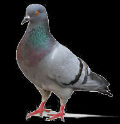
Pigeon`s size is about 33 cm.

Crow`s size is about 62 cm.
One of the fastest ways to eliminate types of birds is to check out the what continents that the suspects live on (or emigrate to).
In spite of the fact that many birds are mockers, the song is one of the strongest indications by which it is possible to identify a bird. At different types the song is various. For example some species of leaf warblers can be determined almost only by the song.
Is it something really strange? Can your bird create giant house-nests? (Estrildidae) Can it perform really strange dances (paradise birds) or intimidate a snake?(
Jynx) Your bird can not only sit on a branch, but also to move on a trunk? (woodpeckers, sítta, parrots) Or it not only move on branches, bird do it with a claws on its wings?! (hoatzin)
Nests and eggs is another way to identificate bird. However I do not call you for this way since you can frighten off a bird and it will be reflected in her posterity. However, if you found in the wood a shell from egg of a wild bird, you can define it and learn what bird lives near you.
The most common silhouettes you can see lower on this page. About flight: different kinds of birds have their unique kind of flight. Also, some species have unique flight so it would be better if you can video it

Some examples of flight:


Some species very strongly differ from others. Thus, you can just gather in the web-searcher: a bird with the crossed beak (crossbill) / long toes (yakan), the huge head (shoebill) and etc.

3.2. Our task - defining to what ordo (formes) our bird belongs.
Thus we will sweep aside enormous quantity of variants. Here are names and silhouettes of bird's ordos. In brackets I will give the English names to some widespread bird species, meeting in this group. (maybe it slightly will facilitate searches). Birds, that have a keel I tried to divide into several logical groups, uniting them on diferent signs.
- In general, more than a half of birds belong to Passeriformes. So it is very probable that your bird belong to them. They have small or average sizes and is frequent, are able to sing beautifully.

(kiwi)
 (
(cassowary
)
( rhea)

(ostrich)

(tinamou)
WITH A KEEL:

(penguins)
* Life is connected with water for this ordos:

(screamers, geese, ducks);

(shorebirds, seagulls, tysties, yakans, skimmers, snipes);

(storks, herons, ibises);

(loons);

(tropicbird, pelicans, cormorants, darters, frigatebirds);

(flamingos);

(grebe);

(albatrosses, shearwaters, petrels);
*Land birds, but have water-lovers:

(cranes, bustards, spotted thick-knee, rails);
*Land (steppe/savannah) birds:

(mousebirds);

(chiken, turkey, grouses, craxi, pheasant);

(sandgrouses);
*Mainly tropical birds:

(quetzal, trogon);

(bee-eaters, trogons, kingfishers, hoopoe, hornbills, rollers);

(hoatzin);

(parrots);
*Mainly forest birds:

(woodpeckers, jacamars, puffbirds, honeyguides, toocans);

(cuckoos, turacos);

(oilbirds, nightjars);
*Common birds:
(robin, sparrow, crow, paradise birds, pitta, nightingale, lyrebird, nuthatch and many others);

(swifts, hummingbirds);

(pigeons);
*Birds of prey:Day predators:
(falcons, hawks, secretarybird, vultures);
Night predators:
(owls);
At this stage - just look for the most similar silhouettes

I always search new bird at begin in
wikipedia, if I'm not sure ^^
Just choose those tribes, that seems most similar to your bird. This way go further until you have chosen several tribes or even species 
Thus choose from remaining groups: familia, genus and species.3.3. There are several species in what I think my bird belongs!
It is possible not to identify the bird to species the first time. If you find in what genus a bird belongs, in some sites people can write about how to to distinguish closely related species. For example
Loxia curvirostra (photo that I show you before you go to
Section 2) distinguishes from
Loxia pytyopsittacus only by song, size
(pytyopsittacus are little bigger
), and by beak -
Loxia pytyopsittacus`s width (thickness) of a beak
and length are almost identical, while
Loxia curvirostra`s width (thickness) of a beak it is less, than length.
So be attentive to details!
Maybe it happens that you met a female. The plumage of females very frequent look like grayscale of plumage of males. Look at these chaffinches:
Female Fringílla coélebs

and Male Fringílla coélebs
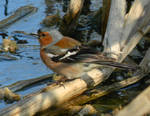

Personally I quickly determine a female of the chaffinch by a white strip on wings, identical at both seks

Here some more hints:
-Search, maybe in your district live not only birds, but also scientists! Then, perhaps you will manage to find the website with a list of all bird species that live in your area 
I found that site: (It is on Russian language) balatsky.ru
-Give preference now to the websites on which there is a detailed description of types, their songs:
-And! If you doubt that defined correctly, be not too lazy, and throw off your photos and video on forums of birders - there you will be helped 
After you identify bird you then can read about it more, and find specially

Because now, you know it preferences, food and of course singing

On DA there is a group AnimalIdentification - you also can ask them for help 
Of course, here a lot of things did not hold, but be sure - any bird can be defined without capturing her and especially -without killing! I consider that it is very important. Also, I am always glad to help to define a bird together with you so be sure to
write me!
*All photographs used in this journal belongs to Lunnika-Horo ; )
Text: Lunnika-Horo; Beta: JenFruzz.
Hope this Tutorial was helpful! ^^ Good luck!  And have a good BIRD MONTH with
And have a good BIRD MONTH with












































